Guide
Everything You Ever Wanted to Know About Form In Place Gaskets
The ultimate collection of information about FIP gasket design, dispensing, and production.
Download PDF.png?width=1024&height=768&name=Pillar%20Hero%20%20FIP%20Gaskets%20(1).png)
What's in this guide
What's in this guide
This guide offers a comprehensive look into Form-In-Place (FIP) gaskets, from the fundamentals to material selection, design considerations, and manufacturer comparisons. It covers the entire lifecycle of FIP gasket integration—from choosing the right material and curing method to designing optimal dispensing paths and understanding tolerances.
Why You Should Read It:
Understand the Basics: Learn what FIP gaskets are, how they work, and why they’re critical in modern electronics, aerospace, medical, and defense industries.
Compare Top Materials: Get side-by-side technical specs for major FIP materials from leading manufacturers like Nolato, Parker Chomerics, Laird, and Momentive.
Optimize Your Design: Discover expert guidance on material selection, gasket geometry, and design for manufacturability (DFM) to ensure reliability and performance.
Master Dispensing Techniques: Learn the nuances of dispensing technology, including bead path design, tolerances, and curing—critical for high-precision applications.
Find the Right Partner: Get tips on choosing a manufacturing partner based on complexity, turnaround, cost, location, and certifications.
Don't have time to read this? Take a copy with you:
Download PDFChapter 1
FIP GASKET BASICS
What is an FIP Gasket?
A form-in-place gasket is created by dispensing a liquid gasket onto a metal or plastic part before assembly. Because it is dispensed as a liquid, it fits precisely to the part’s form, regardless of housing imperfections. This results in a reliable seal and durable finished product.
FIP gaskets are dispensed using CNC machines. The process is so precise that surfaces less than one millimeter wide can still receive FIP gasket application. FIP gaskets are a cost-effective, accurate, and easy sealant solution, particularly in cases where a very small, narrow or complex gasket is required.
Best Uses for FIP Gaskets
Form-in-place gaskets are used in virtually every industry due to their precision, and durability.
FIP is most commonly selected for applications like:
- EMI shielding for electronics
- Environmental sealing for dust or water protection
- Sealing for adhesive reasons to make assembly simpler
Some examples of specific industries and the FIP gasket applications they might require include:
- Electronics: electronic enclosures, GPS systems, satellite communication, semiconductors
- Medical devices: ventilators, oxygenators, heart pumps, dialysis machines
- Defense and military: radar, missile guidance, GPS systems
- Communications: WiFi routers, cellular devices, cellphone stations
- Aerospace: drones, airplane seats, airport ground equipment, flight instrumentation
- Mass transportation: mechanical equipment, seating, accessory components
FIP gasketing provides a highly reliable seal that will stay resistant to freezing, heat, UV, corrosion, and more. Not only is the gasket durable, but it is flexible and can be used on even the most complex of parts.
Advantages of FIP Gaskets
Some of the most important advantages of using form-in-place gaskets are their adaptability across a wide variety of conditions and the ability to produce intricate details. It is possible to dispense large or small gaskets.
Another important benefit is the install speed that FIP allows. Once a FIP gasket is dispensed, there is no additional work to assemble the product. It creates a turnkey solution that is ready for use, when compared to other gasket production methods.
Keep in mind that with such a precise process, there is a huge learning curve to gasket dispensing. It is as much of an art-form as it is a science, so selecting a dispensing partner who has honed the craft is very important.
History of FIP Gaskets
In the 1970s, the first liquid gaskets were manufactured by Shin-Etsu Chemical Company. Made out of room-temperature-vulcanizing (RTV sealant) silicone, Japanese manufacturers used these gaskets to seal engines. Later, ThreeBond International began to supply form-in-place gaskets to Japanese manufacturers.
FIP gaskets quickly caught on in a variety of industries for their precision and ease of use. Because manufacturers no longer had to cut solid gaskets out of material, there was also less wasted material. Today, FIP gaskets are standard for numerous machines and equipment.
As fields like 3D printing and defense sectors use increasingly sophisticated (and delicate) devices, gaskets made with robotic precision are in higher demand. In 2018, the global gaskets and seals market size was about $574.B and is expected to grow by at least 3.7% by 2025. FIP gasket manufacturing is improving and adapting alongside the innovative technology it supports.
Submit a Design
Speak to an Engineer Today
We strive to get every quote turned around in 48 hours or less to make sure you get the information you need faster.
Get a QuoteChapter 2
FIP GASKET MATERIALS
There are various types of materials that are used in FIP gaskets. Depending on the goal of the gasket, you’ll select material that is either conductive or non-conductive. Regardless of conductivity, the FIP gasket’s base material will be the same. Typical choices for base material include:
- Silicone
- Synthetic rubber
- Fluorosilicone
Conductive FIP gaskets require a filler in order to conduct electricity. The material of the conductive filler could be one of the following, or a mixture of more than one:
- Nickel
- Copper
- Aluminum
- Silver
- Graphite
- Ferrite
For the purposes of this guide, we will focus on form-in-place gasket materials from the top four FIP manufacturers. This includes Nolato, Parker Chomerics, Laird, and Momentive.
Each brand of FIP gasket offers varying benefits depending on the specs and nature of your requirements and designs.
To make the selection of the gaskets simple, we’ve gathered the technical data of each of the four suppliers available for reference. Additional information is available directly from the suppliers.
There are two major decisions for selecting the type of FIP paste you’ll use:
- The type of conductive filler used in the FIP paste: This decision will be determined by your design and application needs.
- The cure mechanism for the polymer resin used in the FIP paste: This decision will be determined by a combination of your design needs and turnaround time requirements.
Unsure of which material would be best suited for your design? The Modus Engineering team is on-call to assist with material selection for technical, chemical, and DFM considerations.
Below you will find detailed specifications and information on the following materials:
Nolato TriShield & TriShield 2.0Parker Chomerics | Laird
Momentive |
Nolato TriShield & TriShield 2.0
Trishield® is the trademark for the patented narrow dispensed gaskets based on conductive silicone rubber from Nolato. Production of Trishield® gaskets can be made under license from Nolato.
Nolato is an advanced high-tech polymer partner with operations in Europe, Asia and North America. They develop and manufacture products in materials such as plastic, silicone and TPE.

Nolato TriShield 8817
Nolato 8817 is a conductive silicone rubber with the following properties:
- A two-component thermal cured silicone filled with conductive Ni/C particles.
- It is used to produce integrated EMI shielding gaskets by dispensing Trishield directly on telecom or other industrial components.
- The patented Trishield gasket offers a triangularly shaped narrow gasket with improved shielding properties.
- For a more narrow gasket with less material consumption and less compression force, it is recommended with a triangular shaped needle before using the forming unit.
- Low viscosity offers short cycle times in any dispensing machine.
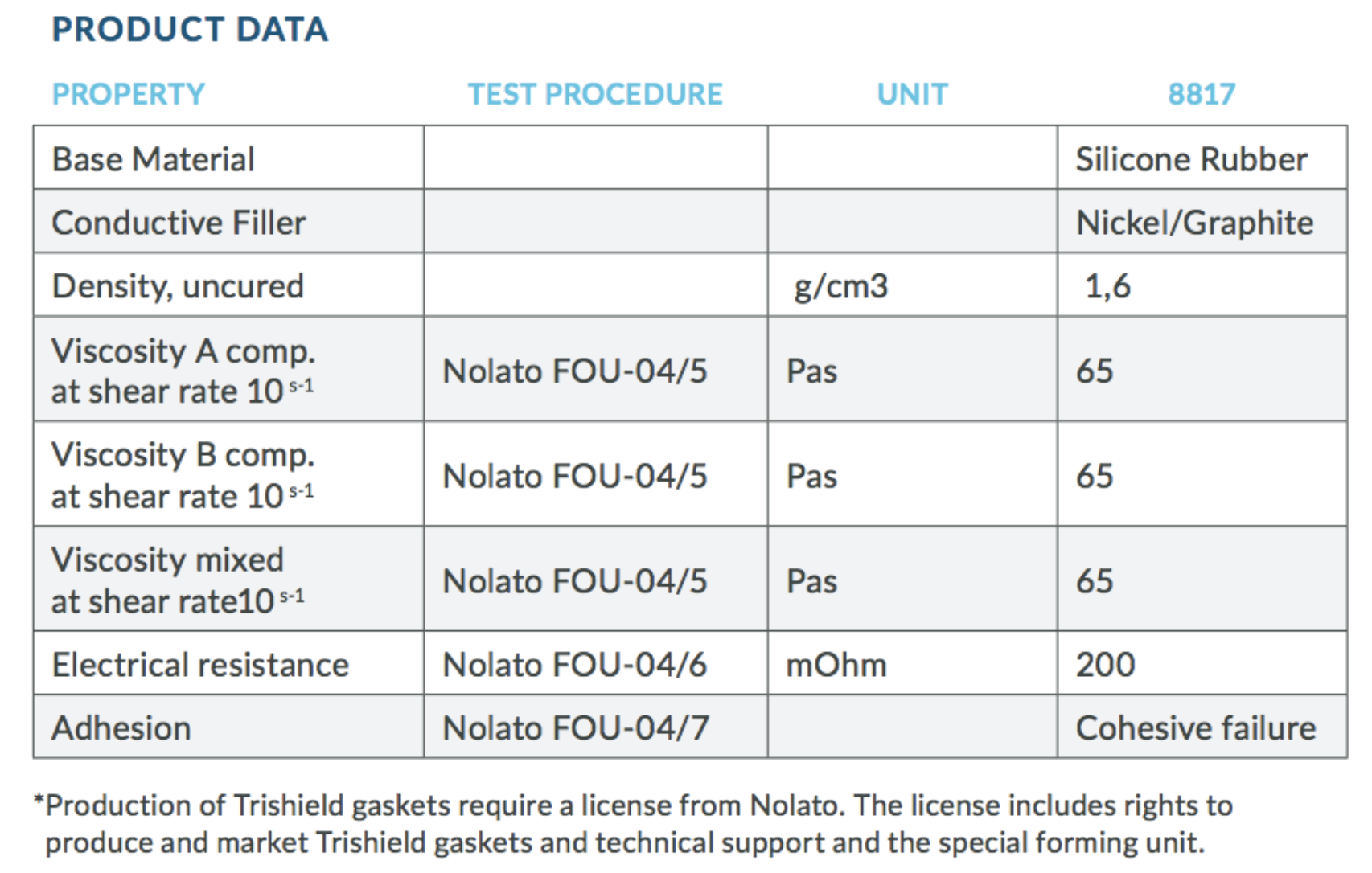
- Excellent shielding combined with good mechanical properties.
- The aluminum compatible conductive filler offers enhanced galvanic corrosion resistance and stability in severe environments.
- Operating temperatures between -55°C and +125°C.
- Good adhesion to most metal and metalized surfaces.
- Typical gasket height from 1,0 to 2,0 mm.
- Recommended compression between 10 and 50%.
Nolato 8817 shielding is a low cost alternative to mass producing gaskets for metallic and plated aluminum housings and castings. Typical applications for this material include EMI shielding gaskets in mobile phone base stations.
Nolato 8817 is a two-component compound, dispensed as a bead directly onto the component with a dispensing machine. The dispensed gasket is given a narrow shape in the Trishield forming unit. Curing is done in a hot air oven at 150°C for 30 minutes.
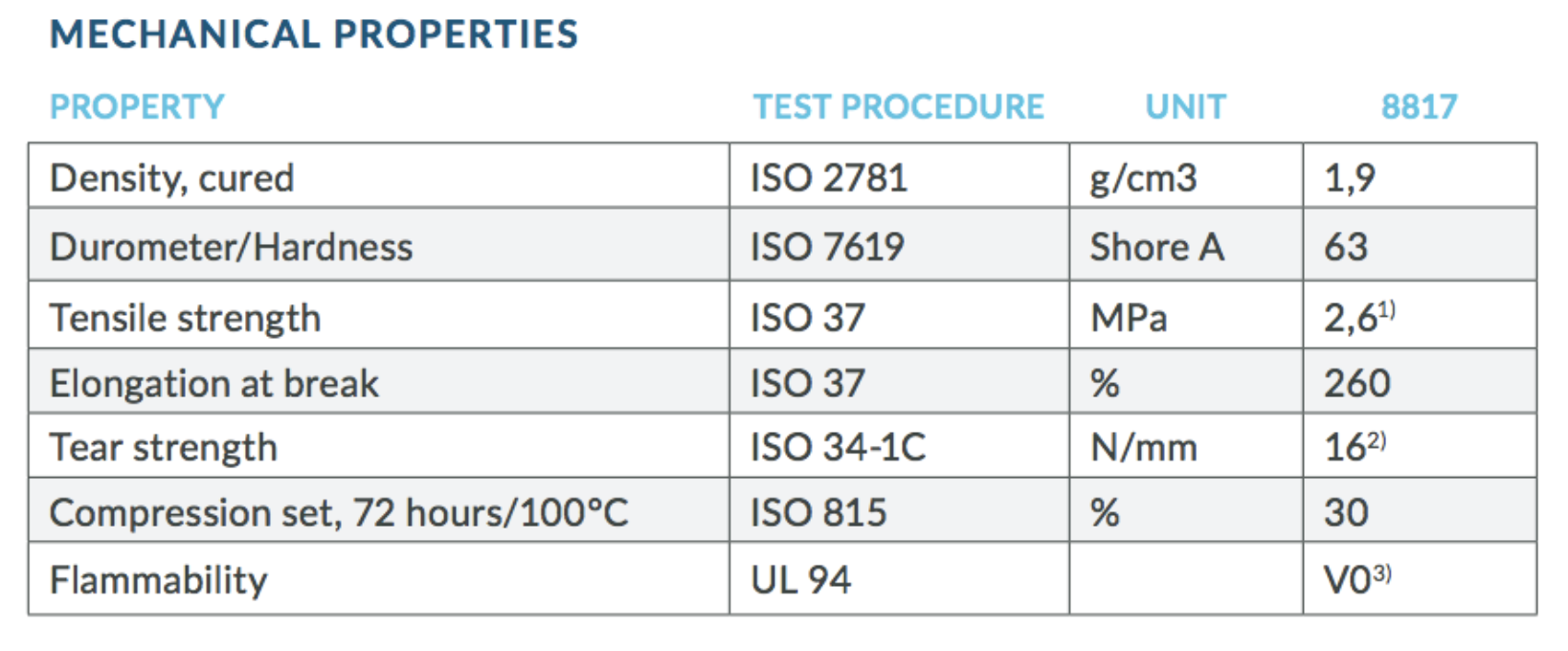

Nolato TriShield 8800
Nolato 8800 is a conductive silicone rubber with the following properties:
- A two-component thermal cured silicone filled with conductive Ag/Ni particles.
- It is used to produce integrated EMI shielding gaskets by dispensing Trishield directly on telecom or other industrial components.
- The patented Trishield gasket offers a triangularly shaped narrow gasket with less material consumption and less compression force.
- Excellent shielding combined with good mechanical properties.
- Low compression forces.
- Operating temperatures between -55°C and +125°C.
- Good adhesion to most metal and metalized surfaces.
- Typical gasket height from 0,8 to 2,0 mm. Width to height ratio is < 1.
- Recommended compression between 10 and 50%.
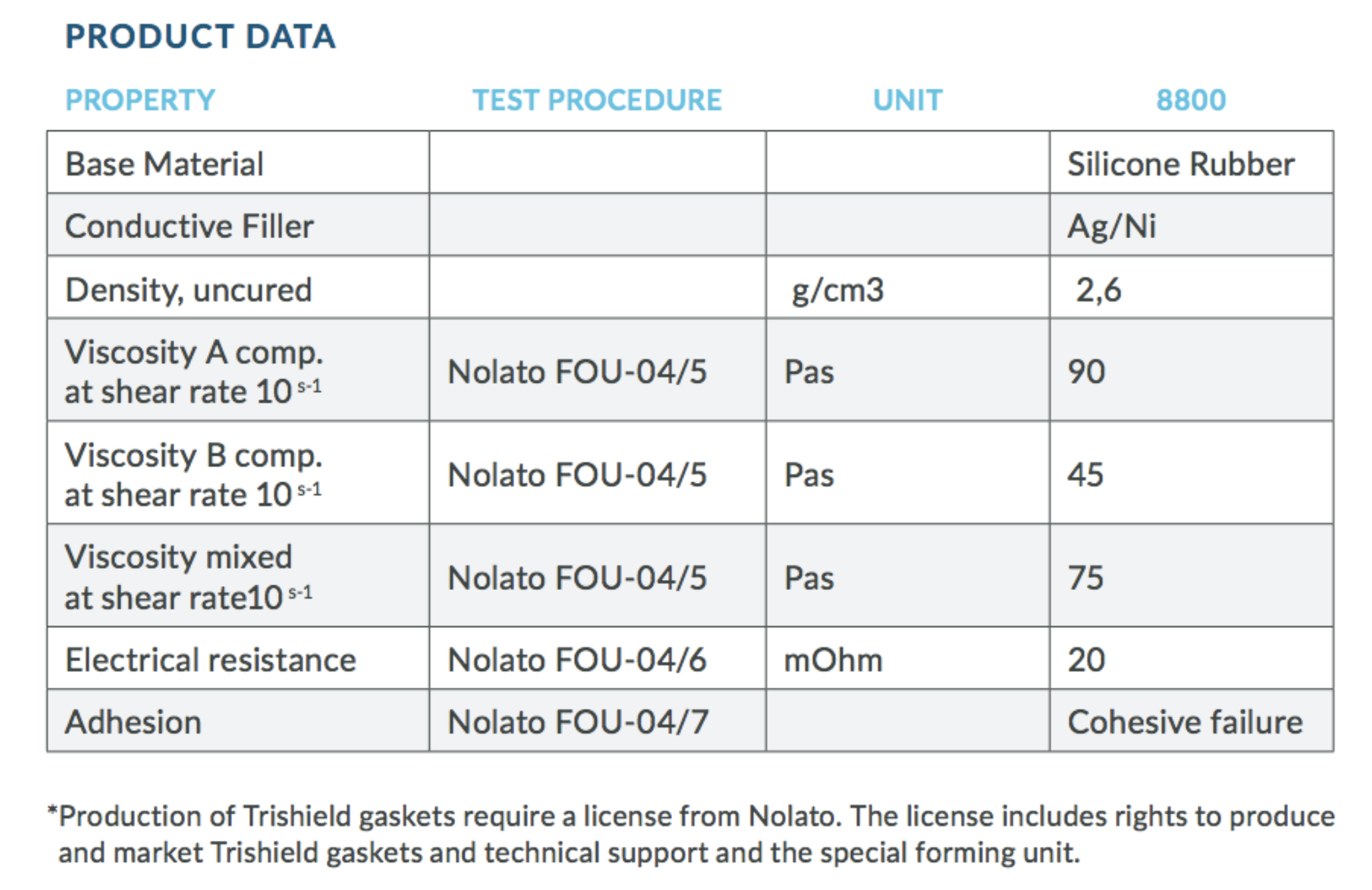
Nolato 8800 shielding is a low cost alternative to mass producing gaskets for metallic and plated aluminum housings and castings. Typical applications for this material include EMI shielding gaskets in mobile phone base stations.
Nolato 8800 is a two-component compound, dispensed as a bead directly onto the component with a dispensing machine. The dispensed gasket is given a narrow shape in the Trishield forming unit. Curing is done in a hot air oven at 150°C for 30 minutes.
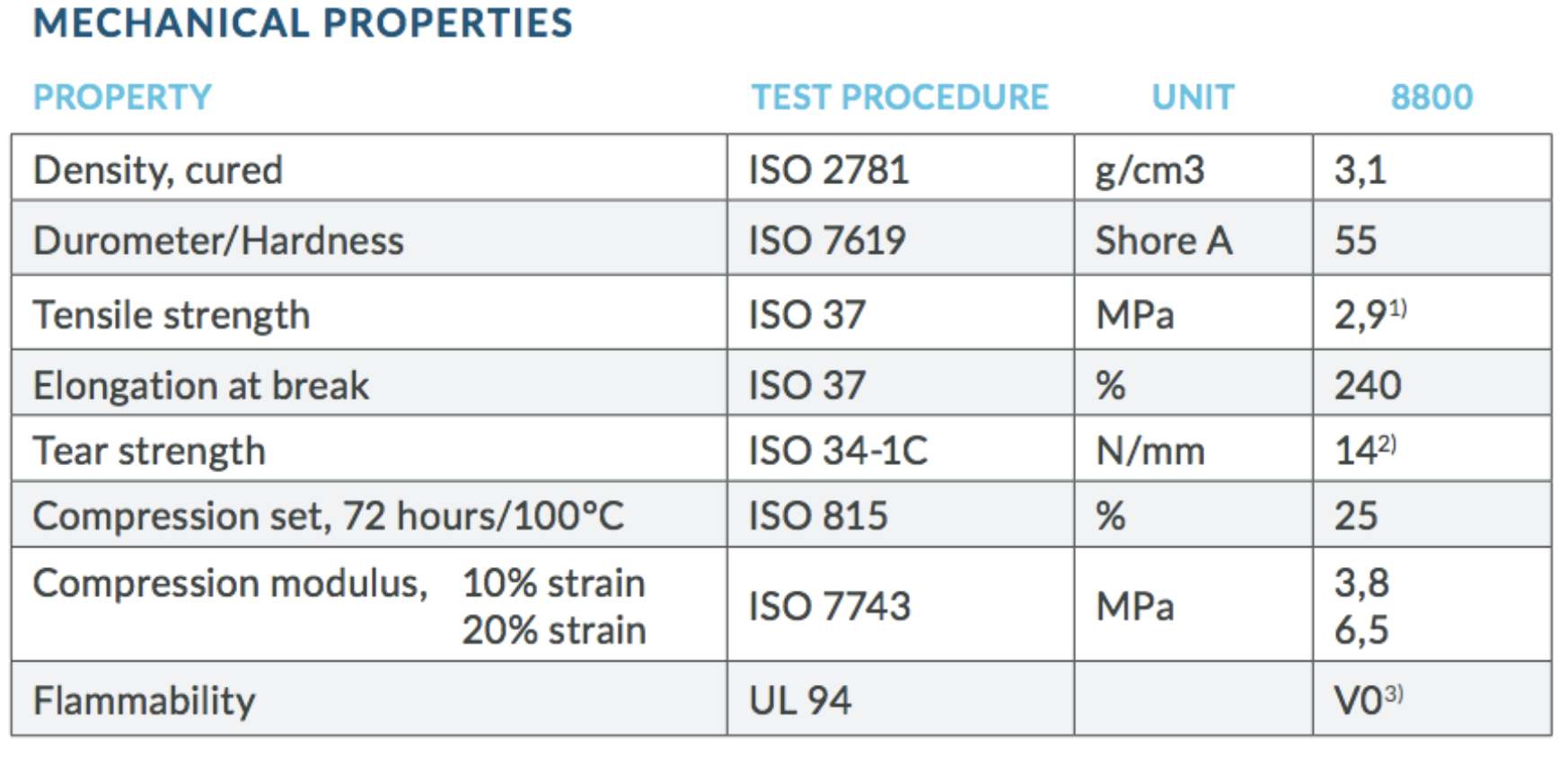
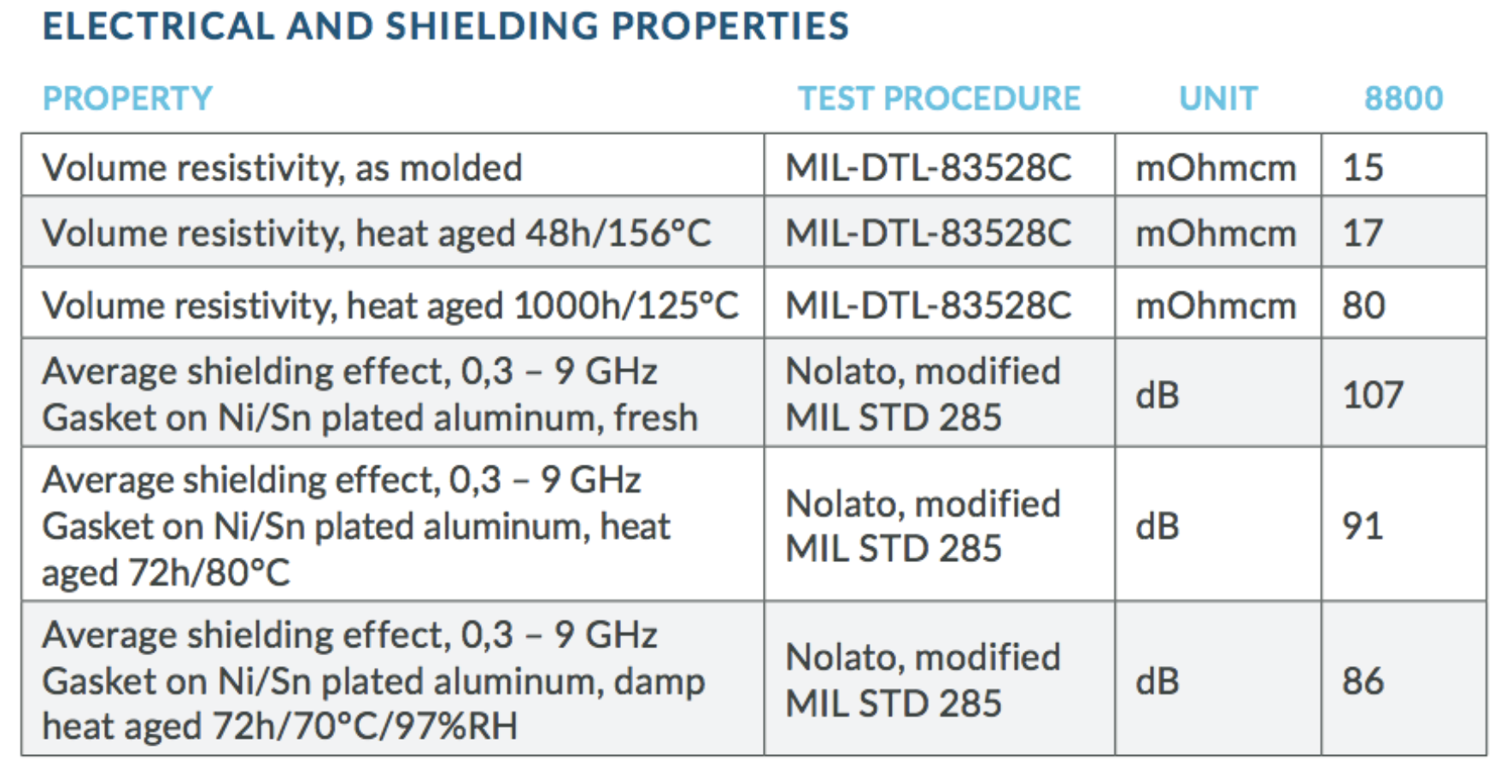
1) 1 MPa= 145 PSI 2) 1N/mm= 5,71 lb/in
3) Tested on a 0,8 mm thick gasket adhered to an aluminum substrate with thickness of 2 mm.
Nolato TriShield 8812
Nolato 8812 is a conductive silicone rubber with the following characteristics:
- A two-component thermal cure silicone filled with conductive Ni/C particles.
- It is used to produce integrated EMI shielding gaskets by dispensing and Trishield forming directly on telecom or other industrial components.
- The patented Trishield gasket* offers a triangularly shaped narrow gasket with less material consumption and less compression force.
- Low viscosity offers short cycle times in any dispensing machine.
- Excellent shielding combined with good mechanical properties.
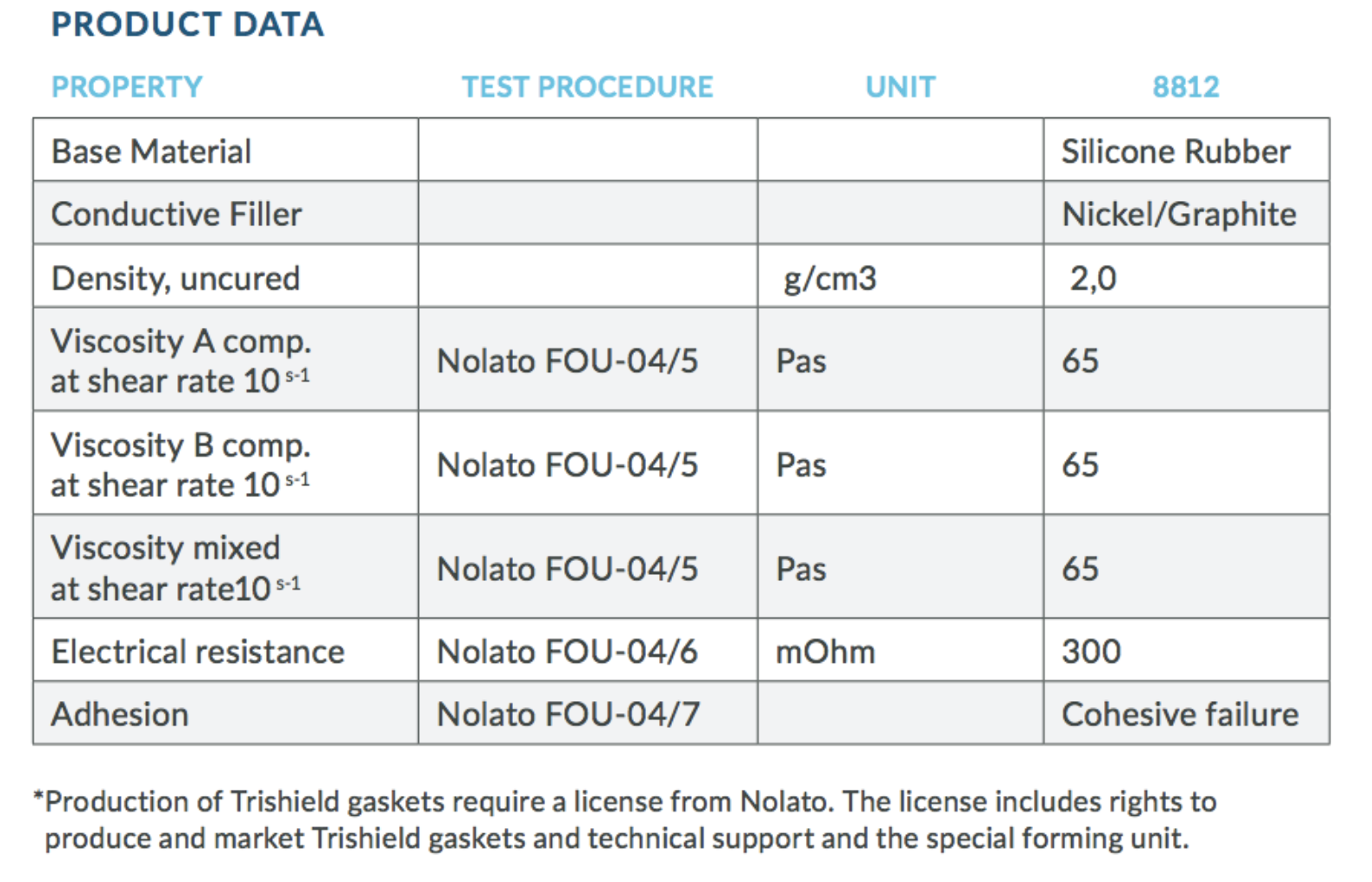
- The aluminum compatible conductive filler offers enhanced galvanic corrosion resistance and stability in severe environments.
- Flammability UL94-V0.
- Operating temperatures between -55°C and +125°C.
- Good adhesion to most metal and metalized surfaces.
- Typical gasket height from 0,8 to 2,0 mm. Width to height ratio is < 1.
- Recommended compression between 10 and 50%.
Nolato 8812 shielding is a low cost alternative to mass producing gaskets for metallic and plated aluminum housings and castings. Typical applications include EMI shielding gaskets in mobile phone base stations.
Nolato 8812 is a two-component compound, dispensed as a bead directly onto the component with a dispensing machine. The dispensed gasket is given a narrow shape in the Trishield forming unit. Curing is done in a hot air oven at 150°C for 30 minutes.
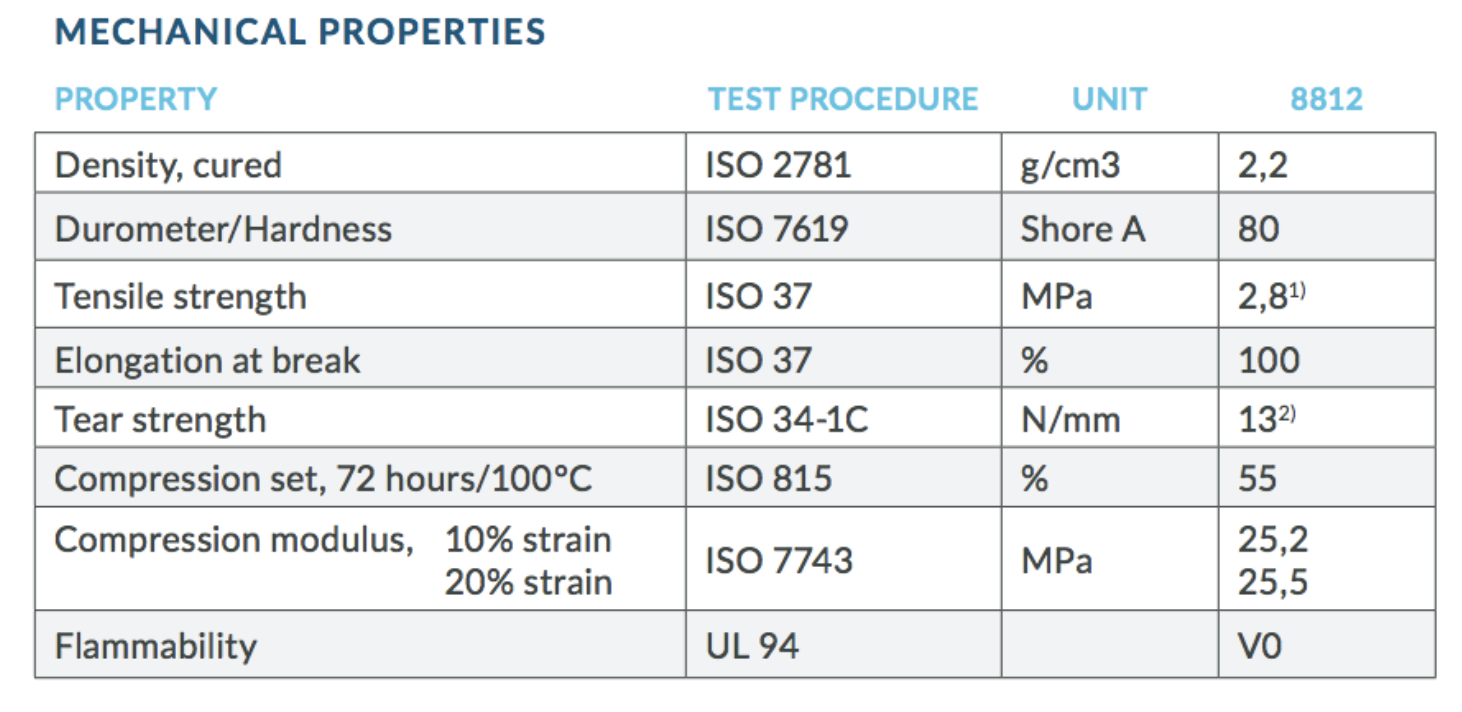

Nolato 8813 is a conductive silicone rubber with the following characteristics:
- A two-component thermal cure silicone filled with conductive Ni/C particles.
- It is used to produce integrated EMI shielding gaskets by dispensing and Trishield forming directly on telecom or other industrial components.
- The patented Trishield gasket* offers a triangularly shaped narrow gasket with less material consumption and less compression force.
- Low viscosity offers short cycle times in any dispensing machine.
- Excellent shielding combined with good mechanical properties.
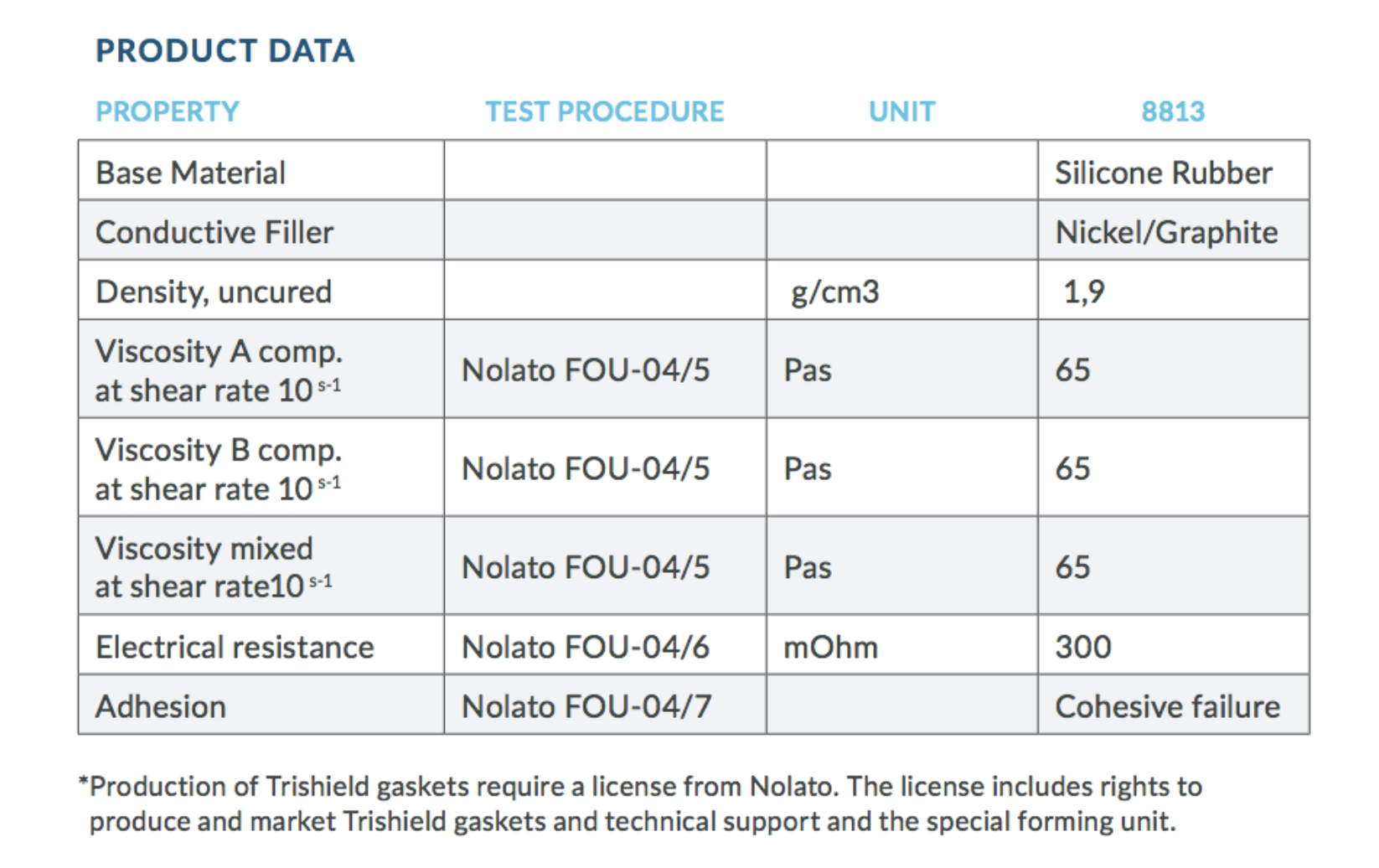
- The aluminum compatible conductive filler offers enhanced galvanic corrosion resistance and stability in severe environments.
- Operating temperatures between -55°C and +125°C.
- Good adhesion to most metal and metalized surfaces.
- Typical gasket height from 0,8 to 2,0 mm. Width to height ratio is < 1.
- Recommended compression between 10 and 50%.
Nolato 8813 shielding is a low cost alternative to mass producing gaskets for metallic and plated aluminum housings and castings. Typical applications include EMI shielding gaskets in mobile phone base stations.
Nolato 8813 is a two-component compound paste, dispensed as a bead directly onto the component with a dispensing machine. The dispensed gasket is given a narrow shape in the Trishield forming unit. Curing is done in a hot air oven at 150°C for 30 minutes.
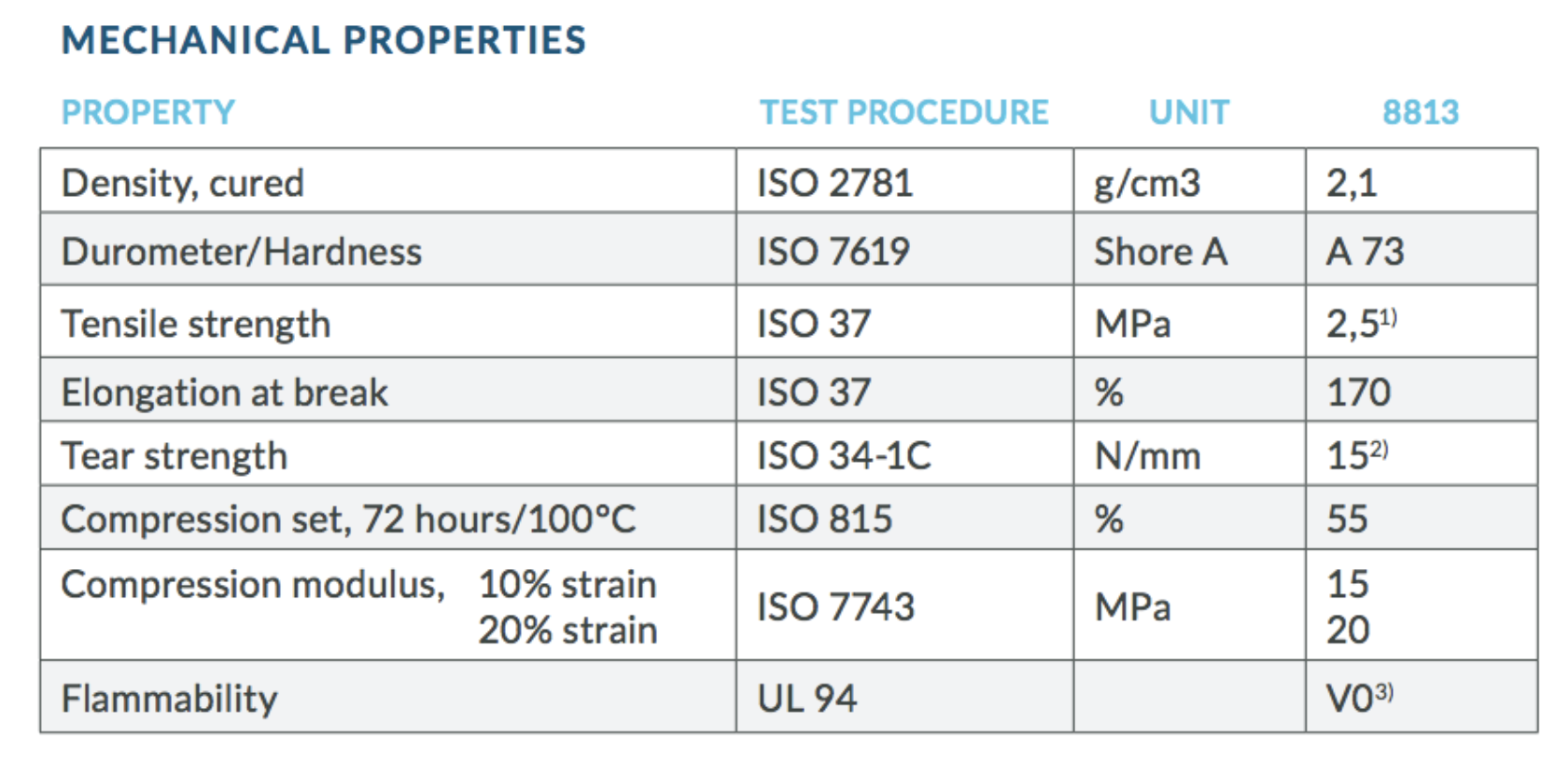

1) 1 MPa = 145 psi
2) 1 N/mm = 5,71 lb/in
3) Tested on a 0,8 mm thick gasket adhered to an aluminum substrate with a thickness of 2mm
Curing Data
Nolato material cures in an oven for 30 to 60 minutes at 100 to 150 deg C. By using heat for curing we can offer shorter lead times, quicker feedback and quality control, better compression set and no risk for silicone bleeding.
Parker Chomerics
Chomerics Division is part of the Parker Hannifin Corporation Engineered Materials Group and is a global leader in the development and application of electrically conductive and thermal interface materials.CHO-FORM®
CHO-FORM is directly dispensed on castings, machined metal, and conductive plastic housings and board shields. It provides excellent electrical contact to mating conductive surfaces including printed circuit board traces.
CHO-FORM is widely used in compartmentalized enclosures and other tightly packaged electronic devices in military, telecom, transportation, aerospace, and life science applications.
CHO-FORM Selector Guide:
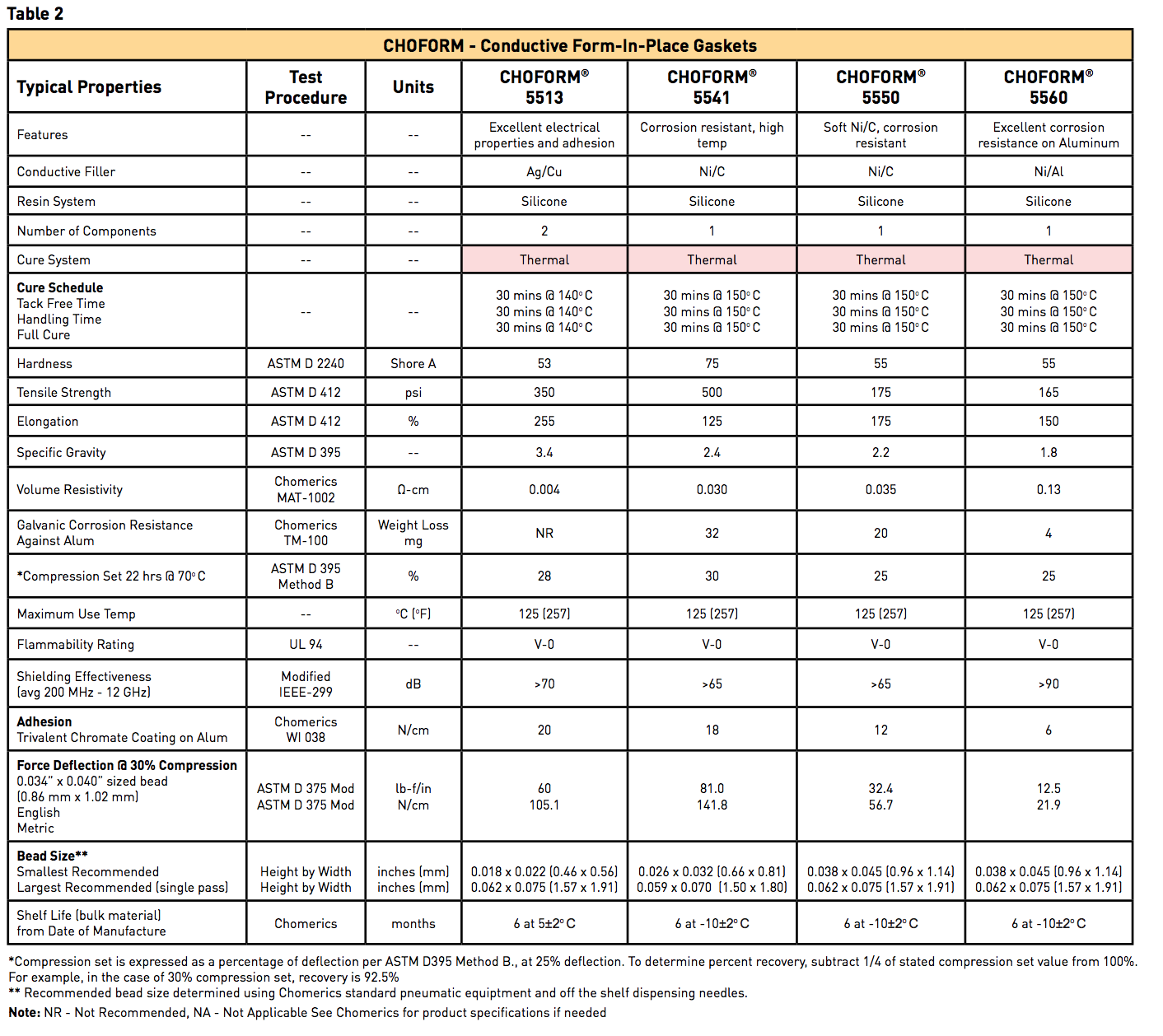
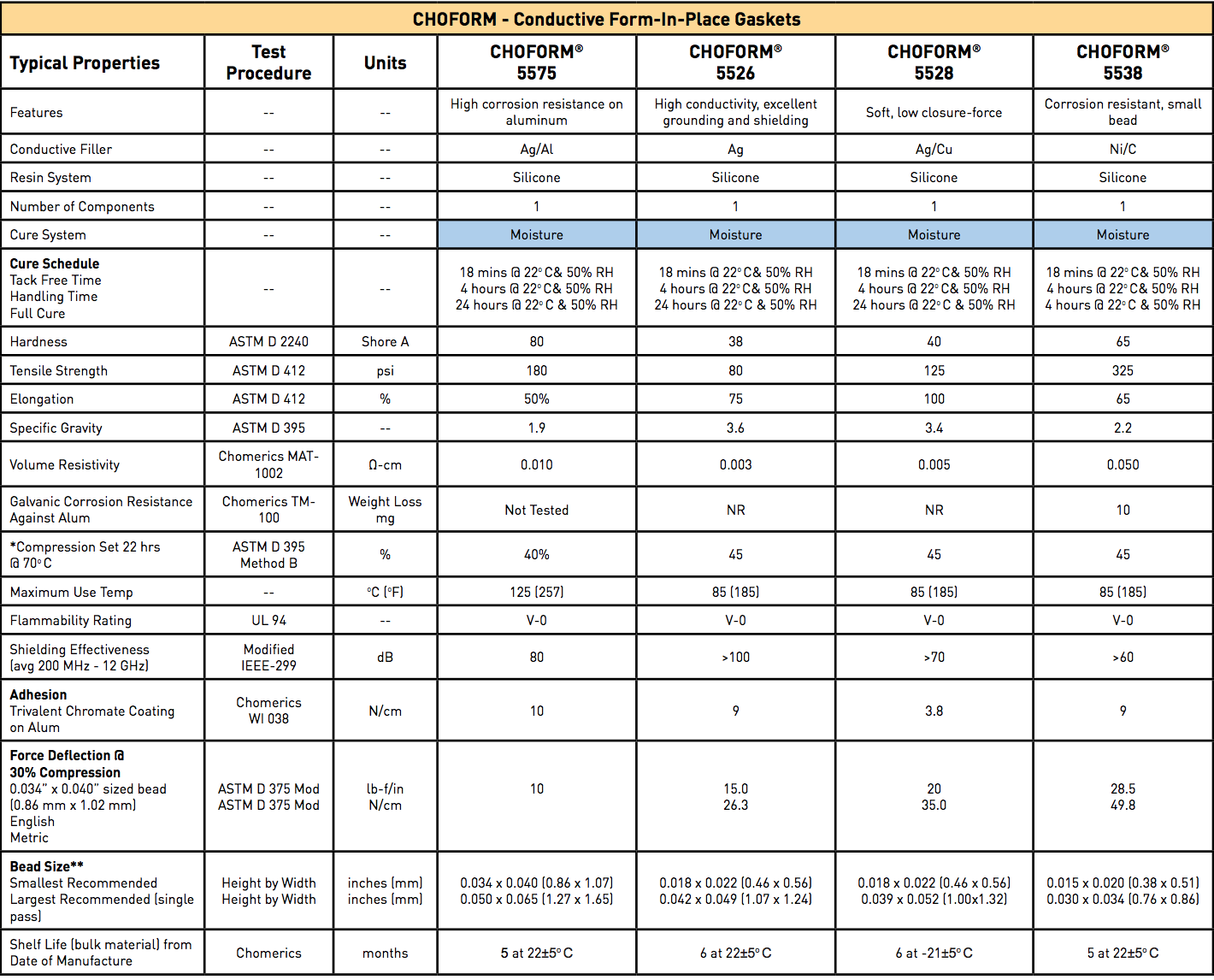
ParPHorm®
Parker Chomerics ParPHorm® is a family of non-conductive form-in-place elastomeric sealing compounds. The product line consists of state-of-the-art compounds designed to be robotically dispensed onto small housings and then cured. Dispensed beads range from 0.018 in (0.46 mm) to 0.062 in (1.57 mm).
Parker Chomerics ParPHorm® 1800 non-conductive, moisture cure, the form-in-place silicone elastomer is specially designed for small enclosures that require a gasket with low closure force, excellent adhesion, and very good compression set qualities. ParPHorm® 1800 is ideal for applications such as handheld electronic modules, battery cases, industrial gauges, fuel cells, and other enclosures requiring environmental or fluid sealing.
ParPHorm® Selector Tool:
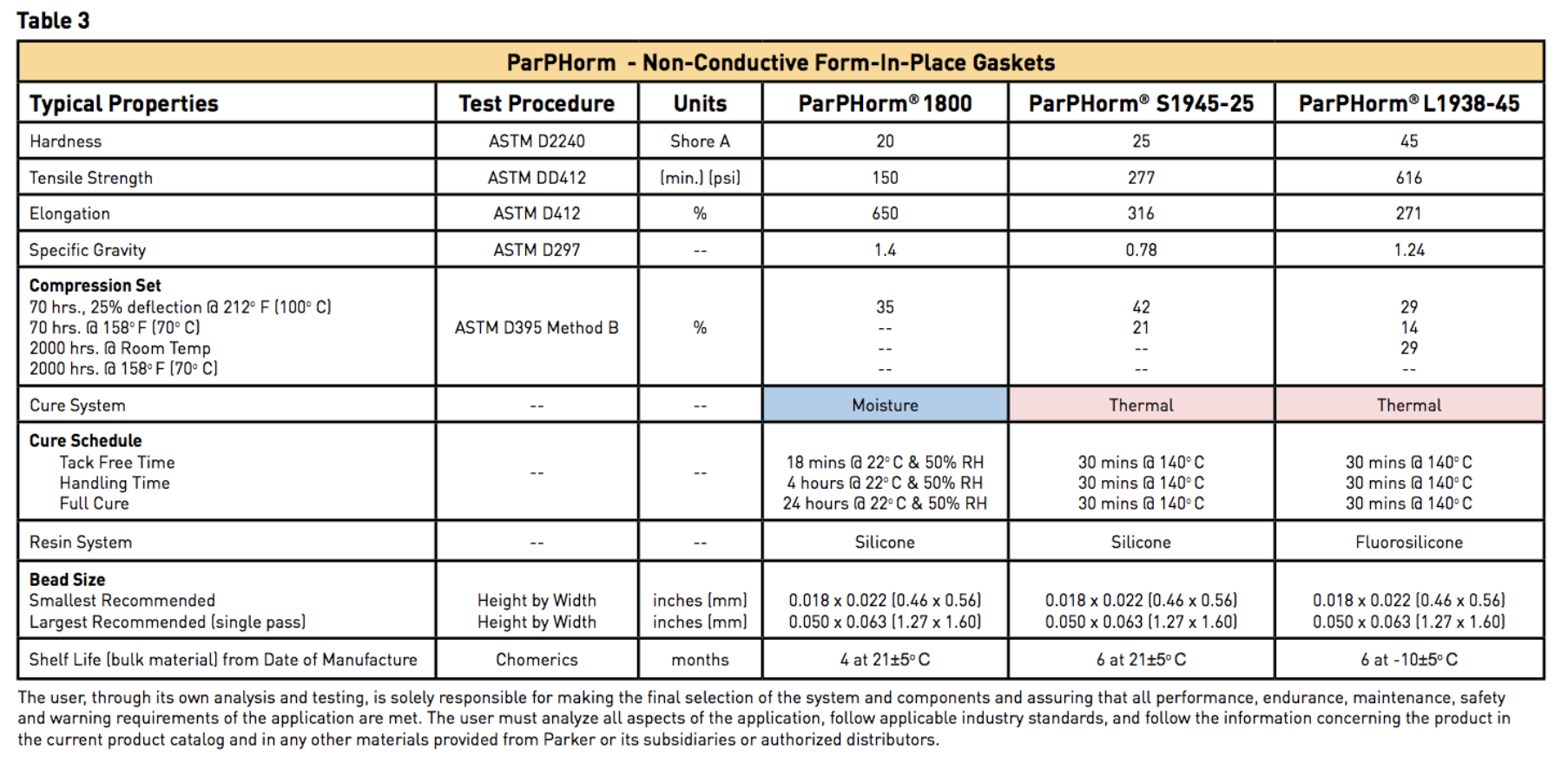
Curing Data
Thermal cure materials are cured at 100– 150 °C (depending on material) for a minimum of 30 minutes. Thermally cured materials have the benefit of allowing the testing and shipping of product the same day the parts are dispensed. Thermally cured materials also offer better properties. In particular, the adhesion properties of thermally cured materials are typically double that of moisture cured material.
The CHO-FORM set of products are all thermal cured, as are both ParPHorm S1954-25 and L1938-45.
Moisture cure materials are cured at room temperature (22 °C, 50 % Rh) for a minimum of 24 hours. Moisture cure materials have the benefit of being dispensed onto low-temperature substrates such as plated plastic, metal parts with external cosmetic (low temperature) paint, conductive painted surfaces & conductive plastic.
Only ParPHorm 1800 uses moisture curing.Laird
In FIP gaskets, conductive fillers contribute to the overall performance and reliability of the resulting device. Laird Technologies uses special metal-coated powder fillers, setting it apart from some of the other vendors. Table 1 indicates the electrical performance characteristics of different fillers. (Table) is a relative guide for galvanic compatibility with the chassis or enclosure.
-1.png)
The table below provides an overview of the various Laird products and comparison of properties for your convenience:
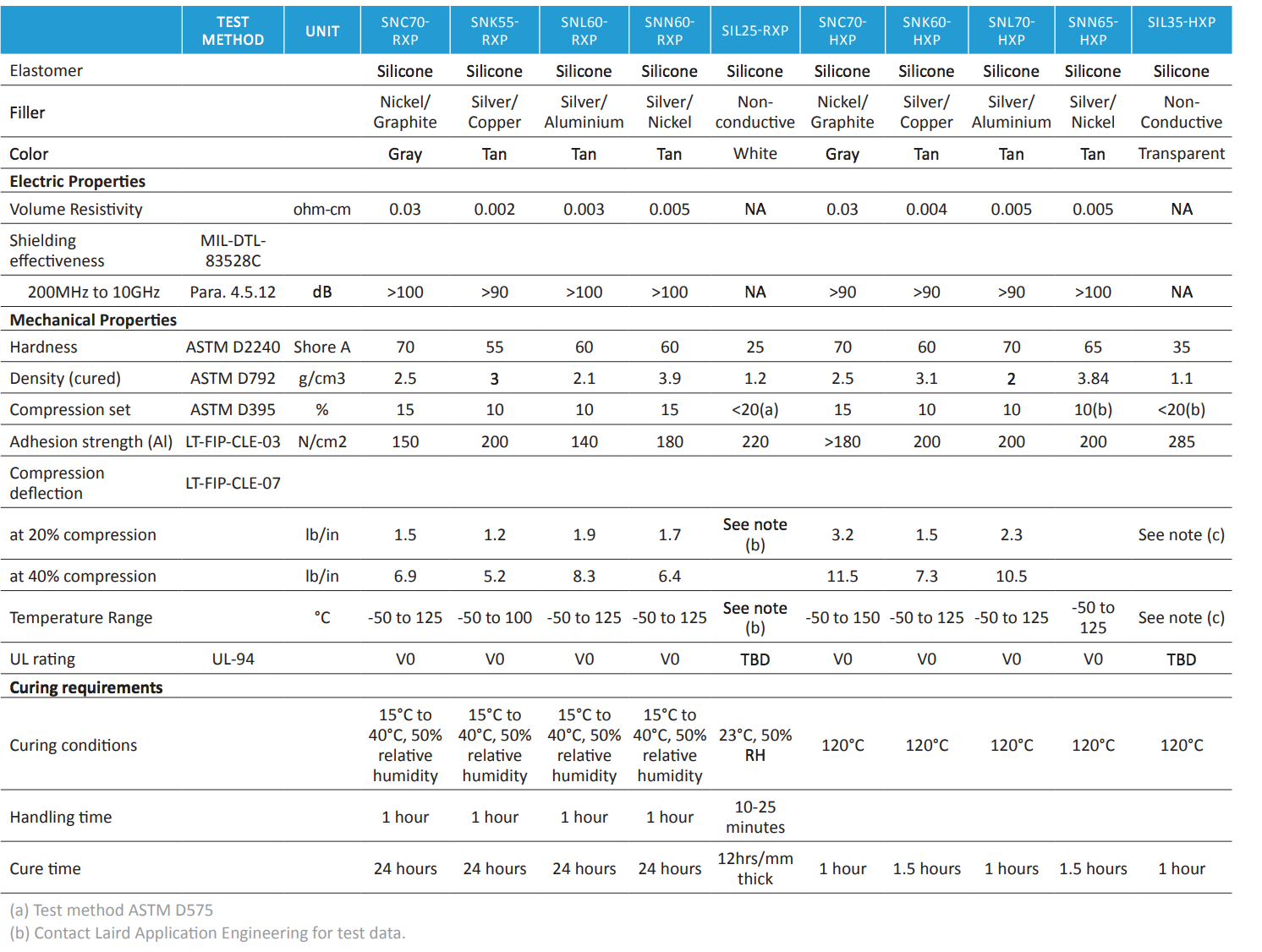
SNC70-RXP
SNC70-RXP is a rapid cure, nickel/graphite-filled silicone elastomer form-in-place gasket material with the following properties:
- Color: Gray
- Compression Set: 15
- Filler Type: Nickel/Graphite
- Gasket Profile: D-Shape
- Hardness: 70
- Operating Temperature Max (Celsius): 125
- Operating Temperature Min (Celsius): -50
- Resin Type: Silicone
- Shielding Effectiveness (dB): >90
- UL Flammability Rating: V0
- Volume Resistivity: 0.03 Ohm-cm
SNK55-RXP
SNK55-RXP is a rapid-cure, silver/copper-filled silicone elastomer form-in-place gasket material with the following features:
- Color: Tan
- Compression Set: 10
- Filler Type: Silver/Copper
- Gasket Profile: D-Shape
- Hardness: 55
- Operating Temperature Max (Celsius): 125
- Operating Temperature Min (Celsius): -50
- Resin Type: Silicone
- Shielding Effectiveness (dB): >90
- UL Flammability Rating: V0
- Volume Resistivity: 0.002 Ohm-cm
SNL60-RXP
SNL60-RXP is a rapid cure, silver/aluminum-filled silicone elastomer form-in-place gasket material with the following properties:
- Color: Tan
- Compression Set: 10
- Filler Type: Silver/Aluminium
- Gasket Profile: D-Shape
- Hardness: 60
- Operating Temperature Max (Celsius): 125
- Operating Temperature Min (Celsius): -50
- Resin Type: Silicone
- Shielding Effectiveness (dB): >100
- UL Flammability Rating: V0
- Volume Resistivity: 0.003 Ohm-cm
SNN60-RXP
SNN60-RXP is a rapid cure, silver/nickel-filled silicone elastomer form-in-place gasket material with the following features:
- Color: Tan
- Compression Set: 15
- Filler Type: Silver/Nickel
- Gasket Profile: D-Shape
- Hardness: 60
- Operating Temperature Max (Celsius): 125
- Operating Temperature Min (Celsius): -50
- Resin Type: Silicone
- Shielding Effectiveness (dB): >100
- UL Flammability Rating: V0
- Volume Resistivity: 0.005 Ohm-cm
SIL25-RXP
SIL25-RXP is a single component, non-slump, high flexibility, room temperature silicone form-in-place gasket material with the following properties:
- Color: White
- Compression Set: <20
- Filler Type: Non-conductive
- Gasket Profile: D-Shape
- Hardness: 25
- Operating Temperature Max (Celsius): 125
- Operating Temperature Min (Celsius): -50
- Resin Type: Silicone
SNC70-HXP
SNC70-HXP is a rapid cure, nickel-coated graphite-filled silicone elastomer form-in-place gasket material with the following features:
- Color: Gray
- Compression Set: 15
- Filler Type: Nickel/Graphite
- Gasket Profile: D-Shape
- Hardness: 70
- Operating Temperature Max (Celsius): 125
- Operating Temperature Min (Celsius): -50
- Resin Type: Silicone
- Shielding Effectiveness (dB): >90
- UL Flammability Rating: V0
- Volume Resistivity: 0.03 Ohm-cm
SNK60-HXP
SNK60-HXP is a heat-cure, silver/copper-filled silicone elastomer form-in-place gasket material with the following properties:
- Color: Tan
- Compression Set: 10
- Filler Type: Silver/Copper
- Gasket Profile: D-Shape
- Hardness: 60
- Operating Temperature Max (Celsius): 125
- Operating Temperature Min (Celsius): -50
- Resin Type: Silicone
- Shielding Effectiveness (dB): >90
- UL Flammability Rating: V0
- Volume Resistivity: 0.004 Ohm-cm
SNL70-HXP
SNL70-HXP is a heat-cure, silver/aluminum-filled silicone elastomer form-in-place gasket material with the following features:
- Color: Tan
- Compression Set: 10
- Filler Type: Silver/Aluminium
- Gasket Profile: D-Shape
- Hardness: 70
- Operating Temperature Max (Celsius): 125
- Operating Temperature Min (Celsius): -50
- Resin Type: Silicone
- Shielding Effectiveness (dB): >90
- UL Flammability Rating: V0
- Volume Resistivity: 0.005 Ohm-cm
SNN65-HXP
SNN65-HXP is a rapid-cure, Ag-coated Nickel-filled silicone elastomer form-in-place gasket material with the following properties:
- Color: Tan
- Compression Set: 10
- Filler Type: Silver/Nickel
- Gasket Profile: D-Shape
- Hardness: 65
- Operating Temperature Max (Celsius): 125
- Operating Temperature Min (Celsius): -50
- Resin Type: Silicone
- Shielding Effectiveness (dB): >100
- UL Flammability Rating: V0
- Volume Resistivity: 0.005 Ohm-cm
SIL35-HXP
SIL35-HXP is a non-slump, single component, high flexibility, thermally curable silicone rubber form-in-place gasket material with the following features:
- Color: Transparent
- Compression Set: <20
- Filler Type: Non-conductive
- Gasket Profile: D-Shape
- Hardness: 35
- Operating Temperature Max (Celsius): 125
- Operating Temperature Min (Celsius): -50
- Resin Type: Silicone
Curing Data
There are two types of FIP cure materials RXP and HXP types. RXP paste is cured in the air, without heat but requires a climate-controlled facility. HXP paste, on the other hand, requires an oven to apply heat for curing. Improper cure of the materials will impact FIP bead shape, electrical and mechanical performance, and in-application reliability.
Specific cure recommendations are given in table 3. Please note that a fan should not be used to ‘air-dry’ the paste or cracking will occur. Both Temperature and humidity are important parameters to control during curing that impact the performance of the final component. Temperature and humidity during dispense and cure should be recorded as part of QA procedures to ensure repeatable and reliable FIP performance.
.png?width=500&height=185&name=unnamed%20(2).png)
Momentive
IS803 Adhesive Sealant
Momentive’s form-in-place gaskets are a one-component silicone sealant and adhesive that cures when exposed to ambient humidity at room temperature. This material has excellent electrical insulation properties as well as the superior weather, ozone and chemical resistance typical of silicone.
The paste-like consistency of this compound allows for application on vertical surfaces in addition to horizontal surfaces. The uncured body of this material is also sufficient to adhere to small objects during the curing process. Momentive’s product number exhibits both low-temperature flexibility and high-temperature performance.
Some of the key benefits of this product include:
- One component
- Paste-like consistency
- Flexible over a wide temperature range
- Excellent electrical insulation properties
- High temperature performance
- Cures in room temperature and ambient humidity conditions
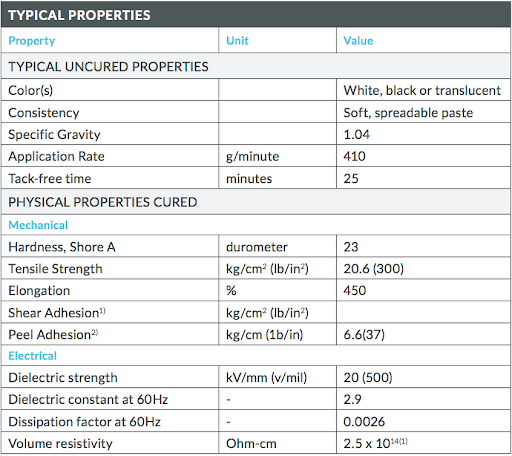
The most common applications for this product include:
- Bonding and sealing
- Electrical insulation
- Joining metals and plastics
- Vertical and overhead uses in thicknesses of up to 6 mm (1/4 in.)
This product is not recommended for the following applications:
- Delicate electrical and electronic components where corrosion is possible
- Sealant thicknesses greater than 6 mm (1/4 in.)
Chapter 3
Related Materials: Absorbers and Thermal Materials
Often many of the applications that require Form in Place gasket dispensing, also require the use of absorbers and thermal materials. See below for a list of some of the best materials to meet those needs.
Mast EMI Suppression Solutions
As electronic packages become smaller and more functional, electromagnetic interference and compliance is an increasingly difficult task. Where traditional metal shields once were effective, now EMI and microwave absorbers are being substituted, due to their thin-film nature and high-frequency absorption properties. MAST Technologies’ electromagnetic interference (EMI) solutions offer absorption of unwanted energy between 200 MHz and 40 GHz.
SARCON® Thermal Interface Materials
More power and lightweight. In the past, these two characteristics in electronics were mutually exclusive. Now, micro-electronics are just that, and in addition, need thermal management components to further complement these objectives.SARCON® is advanced silicone rubber with high thermal conductivity and superior flame-retardancy. By combining the inherent silicone rubber properties of heat resistance, electrical insulation, and long-term aging into one compound, this universally applicable material can be made in an unlimited number of thermal management configurations.
Henkel's BERGQUIST Thermal Management Solutions
Henkel developed the GAP PAD thermal interface material family to meet the electronic industry’s growing need for interface materials with greater conformability, higher thermal performance, and easier application.
GAP PAD provides an effective thermal interface between heat sinks and electronic devices where uneven surface topography, air gaps, and rough surface textures are present.

Laird ECCOSORB®AN Microwave Absorber
ECCOSORB® AN is a series of lightweight, free space, multi-layer, broadband microwave absorbers. Products are made from polyurethane foam that is treated with carbon and assembled in a laminate construction to generate a controlled conductivity gradient. Each product in the series has its own low-end cut-off frequency that forms the basis of selection based on the operating frequency. Reflectivity reduction is at least 17 dB down for normal incident energy with the correct choice of ECCOSORB® AN absorber.
Nolato Compatherm Thermal Pad
Nolato Silikonteknik has expanded its innovative product line to include thermal interface materials (TIMs). Compatherm® thermally conductive gap filler is ideal for applications requiring heat transfer from a PCB to a heat sink. These ultra-soft and conformable materials can drastically cut thermal resistance and greatly enhance cooling by filling air gaps and very small irregularities.
Nolato certifies the thermal conductivity (W/mK) of every pad we deliver. With production capabilities in the USA and China, Modus Advanced, Inc. is positioned to deliver thermal pads anywhere in the world.
Chapter 4
FIP Gasket Dispensing
When should you use a FIP dispenser?
One of the most common questions that arises when choosing to use a FIP gasket is where to have it dispensed. Some organizations will be large enough that building a FIP dispensing function internally is the best choice.
Typically if you are creating highly precise, intricate gaskets for critical applications, you’ll want to turn to a gasket dispenser. This is especially true if you are looking for quick turn production on a relatively low volume of units.
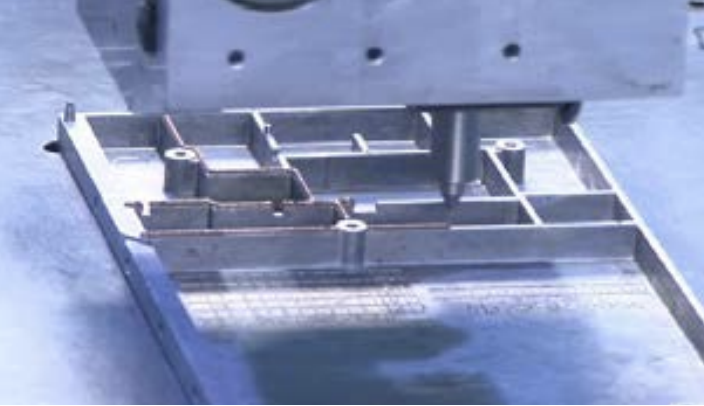
Dispensing Technology
The FIP gasket dispensing process is pretty straightforward. Most manufacturers use robotic gasket dispensing to apply the material to the housing across a specified dispense path. The primary steps to gasket dispensing include:
- The liquid material is inserted into the gasket dispensing machine
- The machine dispenses the material through a needle and applies a gasket bead to the housing, with the dispenser moving across a pre-specified path
- FIP gasket is heat, moisture, or UV light-cured, hardening it
Alternatives to FIP gaskets include the use of pre-cut custom gaskets, but to achieve a precise and cost-effective result, manufacturers rely on automated gasket dispensing technologies. Attempting to apply very small, narrow or complex gaskets by hand significantly increases assembly cost and effort.
FIP gasket dispensers may have the following features:
- CNC dispensing
- Material sensors
- Automatic rotation
- Vertical dispensing
- Needle tip calibration
- Dosing and mixing automation
Some dispensing technologies are perfect for handling critical electronic assembly while others are better suited for simple, small-scale manufacturing. Either way, these machines make FIP gasketing that much more delicate and accurate, resulting in products with high-quality protection.
An illustration of this is Parker Chomerics CHOFORMⓇ Automated EMI Gasketing System. This elite process can dispense onto board shields, conductive plastic housings, machined metal, and castings. It’s an ideal solution for mating conductive surfaces and works well in the compartmentalized enclosures commonly seen in small electronics.
FIP Dispense Path Guidance
One key factor in the DFM process of your gasket is creating the ideal dispensing path. By minimizing starts, stops, and T-spots, together you’ll be able to work with your partner to manufacture an RF shield that meets your requirements the first time.
Below are additional factors to consider when designing your dispense path:
Uncured Gasket Ratio
The uncured gasket ratio is a measure of the dimensions of the wet gasket compared with the dimensions of the resulting cured gasket. These ratios are specific to each material.
You’ll want to account for this is when the gasket path is very close to an adjacent wall. A wet gasket cures towards all surfaces that it is in contact with. If a gasket cures towards an adjacent wall it will not result in a symmetrical gasket.
For instance, in the table below you can see an example of approximate dimensions on a wet gasket, you need to have before the curing step, in order to achieve the standard dimensions for the final gasket for Nolato TriShield materials. It should be noted that the gasket shrinks and loses about 10 % of its weight during curing.
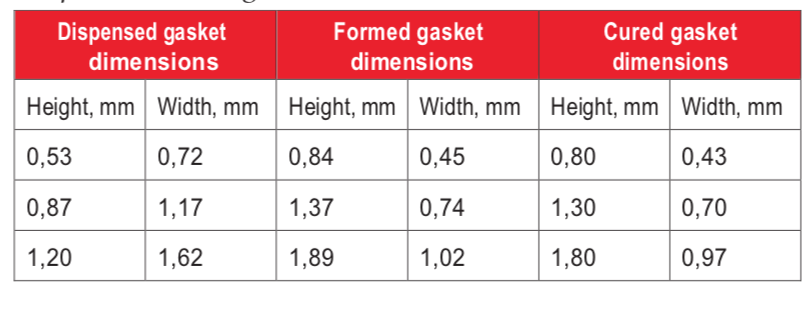
Make sure you are aware of what the dimensions of the wet, or dispensed gasket must be in order to meet the requirements of your final design, once your gasket has cured.
Bead Size Specification
Typically, there are specifications on gasket height and width as well as resistance and adhesion. The most important specification is on the gasket height. In production, there will be variation in gasket height due to variation in the dimensions of the part and variations in the dispensing parameters. Fixturing that can flatten warped parts during dispensing is a good help in keeping variations low.
The width of the gasket is linked to the height due to the free-forming process and the viscosity of the material. Again, these measurements will be specific to the chosen material. See sections below for examples of gasket height tolerances for some of the materials discussed in this guide.
Nolato TriShield
Trishield® formed gaskets are designed as narrow gaskets to reduce cost and compression force. It is strongly recommended to focus on gasket height and specify the width as a maximum value. Typical tolerances on the height and width of Trishield® formed gaskets are shown in the table below.
.png)
Parker Chomerics
For CHOFORM materials, the desired bead compression is 20 – 30 % and it is not recommended to exceed 40%.
CHOFORM materials have a typical height-to-width ratio of 85%. Modus Engineering can work with the customer to determine double bead size.
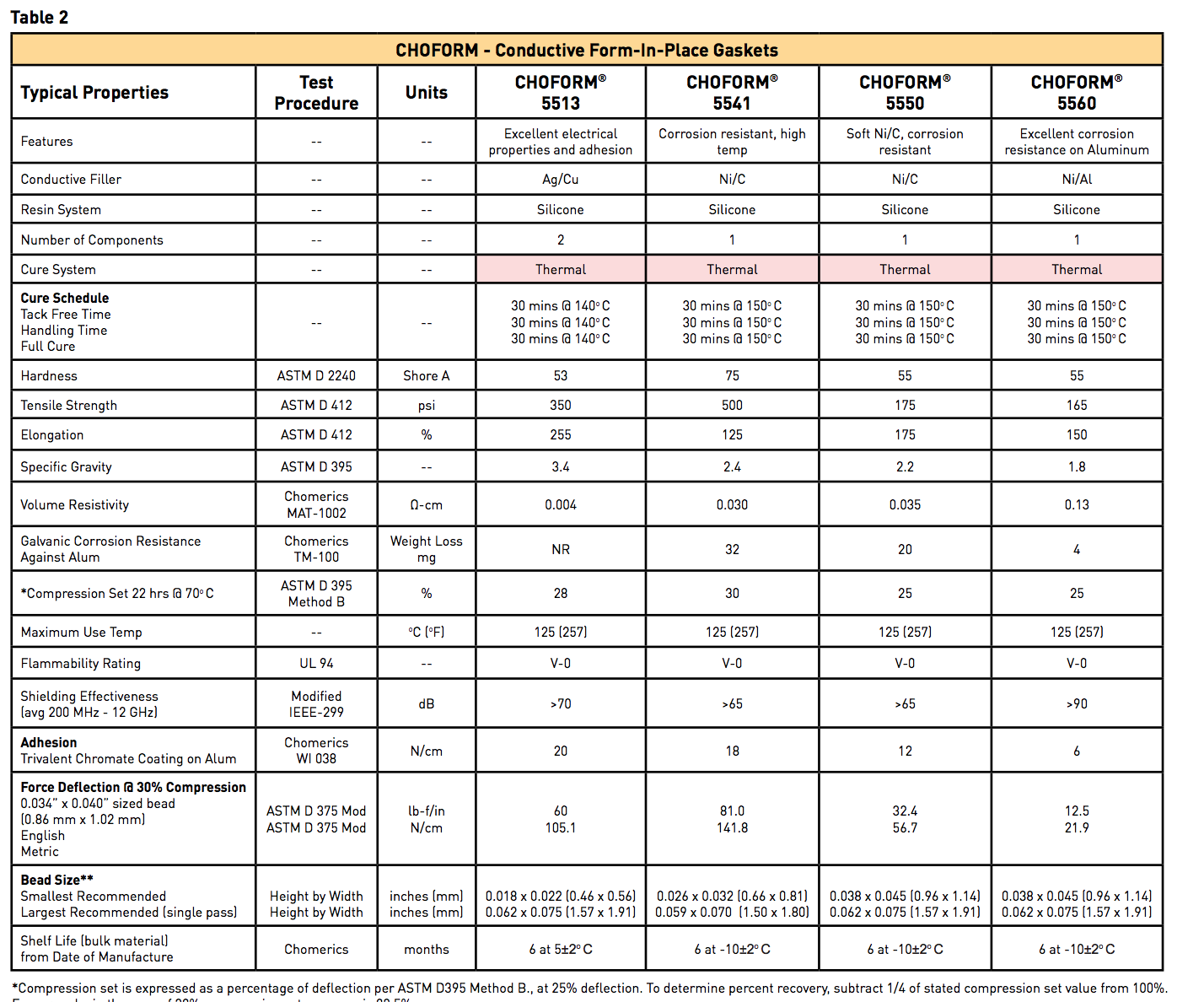
.png)
Laird Bead Specifications
The aspect ratio of the FIP bead for Laird materials varies with the desired height and the FIP paste material selected. 0.80mm is the maximum recommended bead height for a typical 1.0mm bead.
Tolerances
As you may expect, tolerances are critical to any good design. With FIP, height is probably the most important physical tolerance specification and it determines gasket width. The height is conditional and depends on the variation in the dimensions of the part and variations in the dispensing parameters. The width is dependent upon the height due to the free forming process and the viscosity of the material. Both height, and consequently width, must be considered in your design.
Again, these tolerances vary by material. Some examples of these tolerances for some of the materials discussed in this guide are detailed below:
Nolato TriShield
The standard bead height and width tolerances for Nolato TriShield materials are listed in the table below.
.png)
Parker Chomerics
The standard bead height and width tolerances for Parker Chomerics materials are listed in the tables below.
.png)
Start and Stop Locations
The ideal bead path design is a path that isolates all internal compartments from each other. The number of starts and stops will impact the cost of dispensing your gasket. Typically all internal ribs are dispensed first, followed by the closing perimeter bead(s). See the figure below for a typical bead path design.
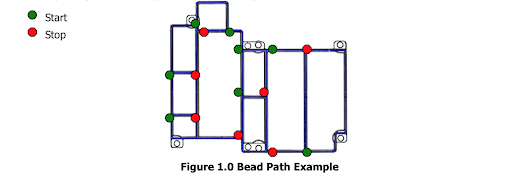
Intersections / T-Spots
In the start and stop zones, there will be a slight difference in the gasket cross-section. The start and stop zones are defined as an area 3 mm in each direction around the location of a start or stop or T-joint. In these areas the height may differ from -30 up to +45 %. The picture below shows a typical T- joint and the start/stop situation.
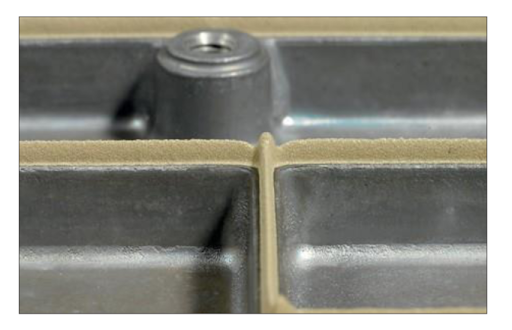
U Sections
As the height of the metal housing changes, either increasing or decreasing, the machines must be adjusted to compensate. Due to the nature of dispensing a fluid, gaskets are often required to start forming at the lowest height and then rising to the highest point.
Stacking Beads
It should be noted that the gasket width varies based on the different materials used. A more particle-filled material is more narrow than a less particle-filled material. Within a single material, the height/width ratio also decreases with increasing gasket height.
In the table below, you can see an example of approximate dimensions on a wet gasket you need to have before the curing step, in order to achieve the standard dimensions for the final gasket. It should be noted that the gasket shrinks and loses about 10% of its weight and volume during curing.
.png)
In case the housing is thinner than recommended in the table below, you can always dispense a second stacked bead.
Short Gasket Segments
The first and final 3mm of a start or stop zone needs to take additional tolerances into consideration. It is possible to have as much as a 45% discrepancy in height in any section shorter than 3mm.
Dispensing in a Groove vs. Flat Surface
It is recommended to fill a groove rather than dispensing on the bottom of a groove though it is not impossible. However, FIP gasket materials are designed to function in a compressed application. Filling a groove with material will affect the material’s compression and could result in a defective gasket.There are specific considerations to factor into the specification when seeking to place a FIP gasket on a flat surface.
You’ll want 1/16” on each side of the width to allow for gasket clearance and to reduce the effect of a magnet on the gasket. This is usually a lot more than an engineer would deem necessary, but that is typically because you are usually focusing on how to use an extrusion that will need a press fit.
True Partnership
Small Bead FIP: Breaking the Bead Size Boundaries of Form-In-Place Gaskets
Many of our Defense partners are challenging the boundaries of technology daily. As technology advances, electronics and devices are shrinking in size to accommodate more complex project designs–simply put, they require more technology in less space. It pays to have a manufacturing part who is willing to push the boundaries.
Visit NowChapter 5
FIP Gasket Design Guidance
Because the dispensing of the FIP gasket is only one part of the process for creating your final product, we’ve also included guidance below on some of the other design parameters that are important to the end result in the creation of a successful gasket.
Material Selection
As outlined above, there are quite a few available materials to choose from. Selecting the right material is one of the most important parts of your gasket design (thus why it was given such a large chunk of consideration in this guide).
Keep in mind that electrically conductive gaskets will need to be compressed by the exact amount specified by the material, and if they aren’t seeing that exact compression force then it might not create the correct seal. So ensuring your design will apply the right compression forces for your chosen material is very important.
Material viscosity also plays a very important role in the design of your part.
If your part requires dispensing in three dimensions rather than just two, then you’ll need to select a high viscosity material to reduce any issues with material slump on the three dimensional sections of your dispense path.
Metal Housing Guidance
We work with engineers early in the design process to ensure the parts they design are easy to dispense FIP gaskets on. We do this to ensure our partners get a more consistent result and produce a better quality final product.
Below are some considerations for the design of your housing to ensure that dispensing onto the housing will be successful.
Wall Dimensions
The dimensions of the wall on which you want to dispense your gasket will be important as well. The narrower the walls, the harder dispensing becomes. Each material will outline the smallest wall dimension onto which you should dispense it.
For instance, CHOFORM material can be applied to walls or flanges as narrow as 0.025” (0.76 mm), and don’t require mechanical retention. Ideally you’ll want to keep the Z height variation as low as possible.
Compression Stops
When compression of the gasket cannot be controlled, compression stops should be provided to prevent gasket rupture that can be caused by overcompression. Each material will provide compression percentages, including a ceiling above which it should not be compressed. Compression stops are recommended when a design may cause compression amounts higher than the ceiling of the material.
These requirements are different per material, general guidances on some of the materials outlined in this guide are listed below:
Nolato TriShield
To achieve a good seal and electrical contact it is recommended that the gasket is compressed between 10 and 50 %. The nominal value could be 20-30 %. Mechanical compression stops are recommended.
Parker Chomerics
The figures and table below give nominal recommended compression ranges for CHO-SEAL and CHO-SEAL materials, assuming standard tolerances.
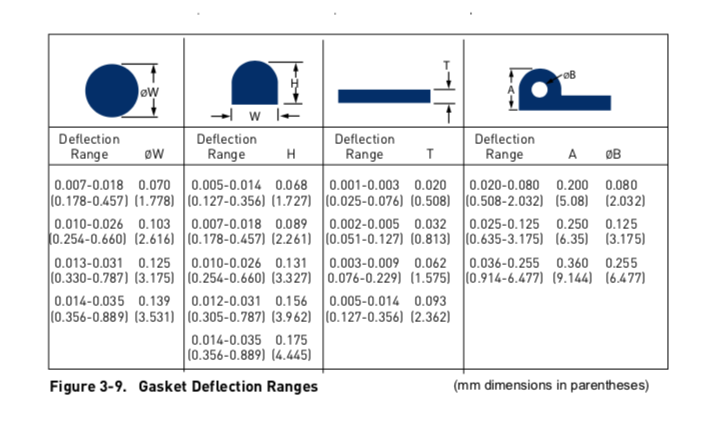
.png)
Design Checklist
This checklist provided by Nolato, is a great starting point to ensure your FIP gaskets will be able to successfully dispensed on your housing:
- How can the part be exactly positioned in the dispensing fixture? Is there a possibility to use a through-hole for a pin positioner or use well-defined corners without gate marks for guiding? Can a vacuum be applied to hold down the part in the fixture?
- Is the part to part reproducibility of the ribs to be dispensed ok? X and Y dimensions should generally be reproducible within 0,2 mm.
- Is the part to part height reproducibility ok? Z dimension i.e. the flatness should generally be reproducible within 0,4 mm
- Is the width of the ribs to be dispensed large enough? A rule of thumb is the rib should be at least 0,4 mm wider than the gasket dispensed width.
- Is the surface for the gasket flat? Radius on top of a rib could reduce the width of the wall.
- Avoid dispensing in grooves since this may give problems to keep height and width tolerances.
- Any sloping surfaces? Dispensing up and downhill is difficult. Dispensing on surfaces with more than a 45- degree angle from horizontal is difficult.
- Can short gasket segments with open ends be avoided? This may give problems with height tolerances.
- Is the dispensing route obstructed by a sidewall or a pin etc? The use of short needles is good for high speed dispensing. A distance of min 0,25 mm is recommended between the gasket and any obstruction.
- Are there dead-end holes? If holes are drilled through the part, there will be less contamination in surface treatment and later on fewer problems with gasket adhesion
- Is there any ferromagnetic material on the housing? This may disturb the gasket shape in the forming process.
Chapter 6
FIP Gasket Manufacturers
When considering FIP gaskets, there are usually two types of companies that come to mind: material manufacturers (which were discussed at length in the FIP Materials section of this guide - Nolato and Parker-Chomerics are examples) and manufacturing companies that are set up to dispense FIP gaskets. FIP gasket dispensing is a specialty process that very few manufacturing companies provide.
In general, with material manufacturers, the old adage of “you get what you pay for” is accurate. Usually, higher end materials will provide a wider range of temperature compatibility, better chemical resistance or improved shielding effectiveness depending on your needs. In addition, material manufacturers that are on the more expensive side tend to have better, more comprehensive technical support.
When comparing manufacturing companies with FIP capabilities, you need to consider several factors:
- Intricacy and complexity of FIP gaskets dispensed: Very complex designs require a unique expertise. Most dispensers will have plenty of experience with simple gaskets, but if you require an especially intricate gasket, you’ll want to find a dispenser who has experience with the level of detail you require. Ask for examples or proof of successful completion of more complex designs.
- Turnaround times: Typically, applications that require FIP dispensing also require the manufacturing of metal housing, plating, thermal materials, and RF absorbers. The more of these processes your dispensing partner has under one roof, the faster you can turn around a final product.
- Cost vs. risk: As with most things in life, you will be balancing reducing your costs with finding a partner that does great work and reduces your risk. Again, vertical integration comes in handy here, as with turnaround times. The more processes available under one roof, the better your balance of risk and cost. Who said you can’t have the best of both worlds?
- Location: With any manufacturing decision, the location of your partner can be important. You must ask yourself several questions. Do you want to manufacture in the United States or offshore, how does it affect lead times, shipping duration and cost, quality, and communication?
- Volumes: Finding a partner that supports your volume needs will be important. Depending on if you need prototype volumes, low production volumes, and even up to high volumes will limit the available partners that can best support you. For instance, we at Modus do best supporting prototype and smaller production volumes (thousands of parts as opposed to millions).
- Certifications: Depending upon your industry, a partner that has the right quality certifications to support you will be of highest importance. You should look for manufacturing companies that have AS9100, ISO 9001, and ITAR certifications. For highly sensitive defense applications, you’ll need a partner that will protect your designs and is working toward achieving CMMC level 3 or 4 compliance.
We’ve said it once, and we’ll say it again: Dispensing is an art as much as it is a science, and there is a very big learning curve. Make sure you select a partner who has honed their craft and has already surpassed the learning curve.
Don't have time to read the entire guide now?
Fill out the form to get a downloadable PDF version of the guide to save so you can read it later.
Get Started
Speak to an Engineer Today
Don’t take our word for it. Reach out and speak to one of our engineers about your part today and see the benefits for yourself. We strive to turn all quotes around 48 hours or less to get your part moving as quickly as possible.
Submit a Design
